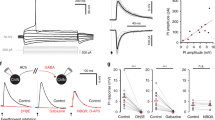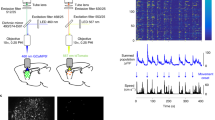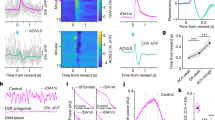Abstract
Cholinergic interneurons in the striatum, also known as tonically active interneurons or TANs, are thought to have a strong effect on corticostriatal plasticity and on striatal activity and outputs, which in turn play a critical role in modulating downstream basal ganglia activity and movement. Striatal TANs can exhibit a variety of firing patterns and responses to synaptic inputs; furthermore, they have been found to display various surges and pauses in activity associated with sensory cues and reward delivery in learning as well as with motor tic production. To help explain the factors that contribute to TAN activity patterns and to provide a resource for future studies, we present a novel conductance-based computational model of a striatal TAN. We show that this model produces the various characteristic firing patterns observed in recordings of TANs. With a single baseline tuning associated with tonic firing, the model also captures a wide range of TAN behaviors found in previous experiments involving a variety of manipulations. In addition to demonstrating these results, we explain how various ionic currents in the model contribute to them. Finally, we use this model to explore the contributions of the acetylcholine released by TANs to the production of surges and pauses in TAN activity in response to strong excitatory inputs. These results provide predictions for future experimental testing that may help with efforts to advance our understanding of the role of TANs in reinforcement learning and in motor disorders such as Tourette’s syndrome.














Similar content being viewed by others
References
Abudukeyoumu N, Hernandez-Flores T, Garcia-Munoz M, Arbuthnott G (2019) Cholinergic modulation of striatal microcircuits. Eur J Neurosci 49(5):604–622
Amédée T, Robert A, Coles J (1997) Potassium homeostasis and glial energy metabolism. Glia 21(1):46–55
Aosaki T, Miura M, Suzuki T, Nishimura K, Masuda M (2010) Acetylcholine-dopamine balance hypothesis in the striatum: an update. Geriatr Gerontol Int 10:S148–S157
Ashby F, Crossley M (2011) A computational model of how cholinergic interneurons protect striatal-dependent learning. J Cogn Neurosci 23(6):1549–1566
Assous M, Kaminer J, Shah F, Garg A, Koós T, Tepper J (2017) Differential processing of thalamic information via distinct striatal interneuron circuits. Nat Commun 8(1):1–14
Barreto E, Cressman JR (2011) Ion concentration dynamics as a mechanism for neuronal bursting. J Biol Phys 37(3):361–373
Bennett B, Callaway J, Wilson C (2000) Intrinsic membrane properties underlying spontaneous tonic firing in neostriatal cholinergic interneurons. J Neurosci 20(22):8493–8503
Brimblecombe KR, Threlfell S, Dautan D, Kosillo P, Mena-Segovia J, Cragg SJ (2018) Targeted activation of cholinergic interneurons accounts for the modulation of dopamine by striatal nicotinic receptors. eNeuro 5(5):2
Bronfeld M, Belelovsky K, Bar-Gad I (2011) Spatial and temporal properties of tic-related neuronal activity in the cortico-basal ganglia loop. J Neurosci 31(24):8713–8721
Bronfeld M, Yael D, Belelovsky K, Bar-Gad I (2013) Motor tics evoked by striatal disinhibition in the rat. Front Syst Neurosci 7:50
Calabresi P, Centonze D, Gubellini P, Pisani A, Bernardi G (2000) Acetylcholine-mediated modulation of striatal function. Trends Neurosci 23(3):120–126
Centonze D, Gubellini P, Pisani A, Bernardi G, Calabresi P (2003) Dopamine, acetylcholine and nitric oxide systems interact to induce corticostriatal synaptic plasticity. Rev Neurosci 14(3):207–216
Choi S, Ma T, Ding Y, Cheung T, Joshi N, Sulzer D, Kang U (2020) Alterations in the intrinsic properties of striatal cholinergic interneurons after dopamine lesion and chronic l-dopa. Elife 9:e56920
Codianni M (2021) Case studies in forcing small motor neural circuits. PhD thesis, University of Pittsburgh
Conceição VA, Dias Â, Farinha AC, Maia TV (2017) Premonitory urges and tics in tourette syndrome: computational mechanisms and neural correlates. Curr Opin Neurobiol 46:187–199
Corbit V, Zitelli K, Crilly S, Rubin J, Gittis A (2016) Pallidostriatal projections promote β oscillations in a dopamine-depleted biophysical network model. J Neurosci 36(20):5556–5571
Ding J, Guzman J, Tkatch T, Chen S, Goldberg J, Ebert P, Surmeier D (2006) Rgs4-dependent attenuation of m 4 autoreceptor function in striatal cholinergic interneurons following dopamine depletion. Nat Neurosci 9(6):832–842
Ding J, Guzman J, Peterson J, Goldberg J, Surmeier D (2010) Thalamic gating of corticostriatal signaling by cholinergic interneurons. Neuron 67(2):294–307
Ding Y, Won L, Britt JP, Lim SAO, McGehee DS, Kang UJ (2011) Enhanced striatal cholinergic neuronal activity mediates l-dopa-induced dyskinesia in parkinsonian mice. Proc Natl Acad Sci 108(2):840–845
Dolezal V, Wecker L (1990) Muscarinic receptor blockade increases basal acetylcholine release from striatal slices. J Pharmacol Exp Ther 252(2):739–743
English D, Ibanez-Sandoval O, Stark E, Tecuapetla F, Buzsáki G, Deisseroth K, Koos T (2012) Gabaergic circuits mediate the reinforcement-related signals of striatal cholinergic interneurons. Nat Neurosci 15(1):123
Ermentrout B (2002) Animating dynamical systems: a guide to xppaut for researchers and students. SIAM, Philadelphia
Fink C, Booth V, Zochowski M (2011) Cellularly-driven differences in network synchronization propensity are differentially modulated by firing frequency. PLoS Comput Biol 7(5):e1002062
Fink C, Murphy G, Zochowski M, Booth V (2013) A dynamical role for acetylcholine in synaptic renormalization. PLoS Comput Biol 9(3):e1002939
Franklin N, Frank M (2015) A cholinergic feedback circuit to regulate striatal population uncertainty and optimize reinforcement learning. Elife 4:e12029
Frost Nylén J, Carannante I, Grillner S, Hellgren Kotaleski J (2021) Reciprocal interaction between striatal cholinergic and low-threshold spiking interneurons-a computational study. Eur J Neurosci 53(7):2135–2148
Gabel L, Nisenbaum E (1999) Muscarinic receptors differentially modulate the persistent potassium current in striatal spiny projection neurons. J Neurophysiol 81(3):1418–1423
Giocomo L, Hasselmo M (2007) Neuromodulation by glutamate and acetylcholine can change circuit dynamics by regulating the relative influence of afferent input and excitatory feedback. Mol Neurobiol 36(2):184–200
Goldberg J, Reynolds J (2011) Spontaneous firing and evoked pauses in the tonically active cholinergic interneurons of the striatum. Neuroscience 198:27–43
Goldberg J, Wilson C (2005) Control of spontaneous firing patterns by the selective coupling of calcium currents to calcium-activated potassium currents in striatal cholinergic interneurons. J Neurosci 25(44):10230–10238
Goldberg J, Teagarden M, Foehring R, Wilson C (2009) Nonequilibrium calcium dynamics regulate the autonomous firing pattern of rat striatal cholinergic interneurons. J Neurosci 29(26):8396–8407
Gritton H, Howe W, Romano M, DiFeliceantonio A, Kramer M, Saligrama V, Han X (2019) Unique contributions of parvalbumin and cholinergic interneurons in organizing striatal networks during movement. Nat Neurosci 22(4):586–597
Hemond P, Epstein D, Boley A, Ascoli G, Jaffe D (2008) Distinct classes of pyramidal cells exhibit mutually exclusive firing patterns in hippocampal area ca3b. Hippocampus 18(4):411–424
Higley M, Soler-Llavina G, Sabatini B (2009) Cholinergic modulation of multivesicular release regulates striatal synaptic potency and integration. Nat Neurosci 12(9):1121–1128
Howe A, Surmeier D (1995) Muscarinic receptors modulate n-, p-, and l-type ca2+ currents in rat striatal neurons through parallel pathways. J Neurosci 15(1):458–469
Ishii M, Kurachi Y (2006) Muscarinic acetylcholine receptors. Curr Pharm Des 12(28):3573–3581
Kim T, Capps R, Hamade K, Barnett W, Todorov D, Latash E, Molkov Y (2019) The functional role of striatal cholinergic interneurons in reinforcement learning from computational perspective. Front Neural Circ 13(10):2
Kondabolu K, Roberts E, Bucklin M, McCarthy M, Kopell N, Han X (2016) Striatal cholinergic interneurons generate beta and gamma oscillations in the corticostriatal circuit and produce motor deficits. Proc Natl Acad Sci 113(22):E3159–E3168
Kreitzer A (2009) Physiology and pharmacology of striatal neurons. Annu Rev Neurosci 32:127–147
Kreitzer A, Berke J (2011) Investigating striatal function through cell-type-specific manipulations. Neuroscience 198:19–26
Krishnan G, Chauvette S, Shamie I, Soltani S, Timofeev I, Cash S, Bazhenov M (2016) Cellular and neurochemical basis of sleep stages in the thalamocortical network. Elife 5:e18607
Lim SAO, Xia R, Ding Y, Won L, Ray WJ, Hitchcock SA, McGehee DS, Kang UJ (2015) Enhanced histamine h2 excitation of striatal cholinergic interneurons in l-dopa-induced dyskinesia. Neurobiol Dis 76:67–76
Maurice N, Mercer J, Chan C, Hernandez-Lopez S, Held J, Tkatch T, Surmeier D (2004) D2 dopamine receptor-mediated modulation of voltage-dependent na+ channels reduces autonomous activity in striatal cholinergic interneurons. J Neurosci 24(46):10289–10301
McCarthy M, Brown E, Kopell N (2008) Potential network mechanisms mediating electroencephalographic beta rhythm changes during propofol-induced paradoxical excitation. J Neurosci 28(50):13488–13504
McCarthy M, Moore-Kochlacs C, Gu X, Boyden E, Han X, Kopell N (2011) Striatal origin of the pathologic beta oscillations in parkinson’s disease. Proc Natl Acad Sci 108(28):11620–11625
McKinley J, Shi Z, Kawikova I, Hur M, Bamford I, Devi S, Bamford N (2019) Dopamine deficiency reduces striatal cholinergic interneuron function in models of parkinson’s disease. Neuron 103(6):1056–1072
Moehle M, Conn P (2019) Roles of the m4 acetylcholine receptor in the basal ganglia and the treatment of movement disorders. Mov Disord 34(8):1089–1099
Moghaddam B, Adams R (1987) Regional differences in resting extracellular potassium levels of rat brain. Brain Res 406(1–2):337–340
Morris G, Arkadir D, Nevet A, Vaadia E, Bergman H (2004) Coincident but distinct messages of midbrain dopamine and striatal tonically active neurons. Neuron 43(1):133–143
Nisenbaum E, Wilson C, Foehring R, Surmeier D (1996) Isolation and characterization of a persistent potassium current in neostriatal neurons. J Neurophysiol 76(2):1180–1194
Nosaka D, Wickens J (2022) Striatal cholinergic signaling in time and space. Molecules 27(4):1202
Orth M, Amann B, Robertson M, Rothwell J (2005) Excitability of motor cortex inhibitory circuits in tourette syndrome before and after single dose nicotine. Brain 128(6):1292–1300
Pakhotin P, Bracci E (2007) Cholinergic interneurons control the excitatory input to the striatum. J Neurosci 27(2):391–400
Perez-Lloret S, Barrantes FJ (2016) Deficits in cholinergic neurotransmission and their clinical correlates in parkinson’s disease. NPJ Parkinson’s Dis 2(1):1–12
Pisani A, Bernardi G, Ding J, Surmeier D (2007) Re-emergence of striatal cholinergic interneurons in movement disorders. Trends Neurosci 30(10):545–553
Pogorelov V, Xu M, Smith H, Buchanan G, Pittenger C (2015) Corticostriatal interactions in the generation of tic-like behaviors after local striatal disinhibition. Exp Neurol 265:122–128
Reynolds J, Hyland B, Wickens J (2004) Modulation of an afterhyperpolarization by the substantia nigra induces pauses in the tonic firing of striatal cholinergic interneurons. J Neurosci 24(44):9870–9877
Shen W, Hamilton S, Nathanson N, Surmeier D (2005) Cholinergic suppression of kcnq channel currents enhances excitability of striatal medium spiny neurons. J Neurosci 25(32):7449–7458
Song W, Tkatch T, Baranauskas G, Ichinohe N, Kitai S, Surmeier D (1998) Somatodendritic depolarization-activated potassium currents in rat neostriatal cholinergic interneurons are predominantly of the a type and attributable to coexpression of subunits. J Neurosci 18(9):3124–3137
Stiefel K, Gutkin B, Sejnowski T (2008) Cholinergic neuromodulation changes phase response curve shape and type in cortical pyramidal neurons. PLoS ONE 3(12):e3947
Surmeier D, Song W, Yan Z (1996) Coordinated expression of dopamine receptors in neostriatal medium spiny neurons. J Neurosci 16(20):6579–6591
Tan CO, Bullock D (2008) A dopamine-acetylcholine cascade: simulating learned and lesion-induced behavior of striatal cholinergic interneurons. J Neurophysiol 100(4):2409–2421
Terman D, Rubin JE, Yew A, Wilson C (2002) Activity patterns in a model for the subthalamopallidal network of the basal ganglia. J Neurosci 22(7):2963–2976
Wang Y, Rubin JE (2020) Complex bursting dynamics in an embryonic respiratory neuron model. Chaos 30(4):043127
Wilson C (2005) The mechanism of intrinsic amplification of hyperpolarizations and spontaneous bursting in striatal cholinergic interneurons. Neuron 45(4):575–585
Wilson C, Goldberg J (2006) Origin of the slow afterhyperpolarization and slow rhythmic bursting in striatal cholinergic interneurons. J Neurophysiol 95(1):196–204
Witten I, Lin S, Brodsky M, Prakash R, Diester I, Anikeeva P, Deisseroth K (2010) Cholinergic interneurons control local circuit activity and cocaine conditioning. Science 330(6011):1677–1681
Zhang W, Basile A, Gomeza J, Volpicelli L, Levey A, Wess J (2002) Characterization of central inhibitory muscarinic autoreceptors by the use of muscarinic acetylcholine receptor knock-out mice. J Neurosci 22(5):1709–1717
Zhang Y, Reynolds J, Cragg S (2018) Pauses in cholinergic interneuron activity are driven by excitatory input and delayed rectification, with dopamine modulation. Neuron 98(5):918–925
Zhou F, Wilson C, Dani J (2002) Cholinergic interneuron characteristics and nicotinic properties in the striatum. J Neurobiol 53(4):590–605
Zucca S, Zucca A, Nakano T, Aoki S, Wickens J (2018) Pauses in cholinergic interneuron firing exert an inhibitory control on striatal output in vivo. Elife 7:e32510
Funding
This work was partially supported by the NSF CRCNS under Award DMS 1724240 and the NSF under Award DMS 1951095. The authors thank Izhar Bar-Gad and Fred Hamker and their lab members for discussions related to this work.
Author information
Authors and Affiliations
Corresponding author
Ethics declarations
Data availability
No original experimental data were involved in this study. Codes used for model simulations will be made publicly available at ModelDB (https://senselab.med.yale.edu/ModelDB/) upon acceptance of this work for publication.
Conflict of interest
The authors declare no competing financial interests.
Significance statement
Despite a growing recognition that striatal cholinergic interneurons, also known as tonically active neurons (TANs), can significantly impact synaptic plasticity and firing patterns of projection neurons in the striatum, there has been relatively little computational work to simulate and analyze their properties. We address this gap by developing a computational model of TANs, fit to match a large collection of experimental results. Simulations of the computational model allow us to analyze the roles of various transmembrane currents in producing TAN responses and the contribution of acetylcholine released by TANs in sculpting their activity in response to excitatory inputs, which could have implications for reinforcement learning and for motor tics in conditions such as Tourette’s syndrome.
Additional information
Publisher's Note
Springer Nature remains neutral with regard to jurisdictional claims in published maps and institutional affiliations.
Rights and permissions
Springer Nature or its licensor (e.g. a society or other partner) holds exclusive rights to this article under a publishing agreement with the author(s) or other rightsholder(s); author self-archiving of the accepted manuscript version of this article is solely governed by the terms of such publishing agreement and applicable law.
About this article
Cite this article
Codianni, M.G., Rubin, J.E. A spiking computational model for striatal cholinergic interneurons. Brain Struct Funct 228, 589–611 (2023). https://doi.org/10.1007/s00429-022-02604-9
Received:
Accepted:
Published:
Issue Date:
DOI: https://doi.org/10.1007/s00429-022-02604-9




